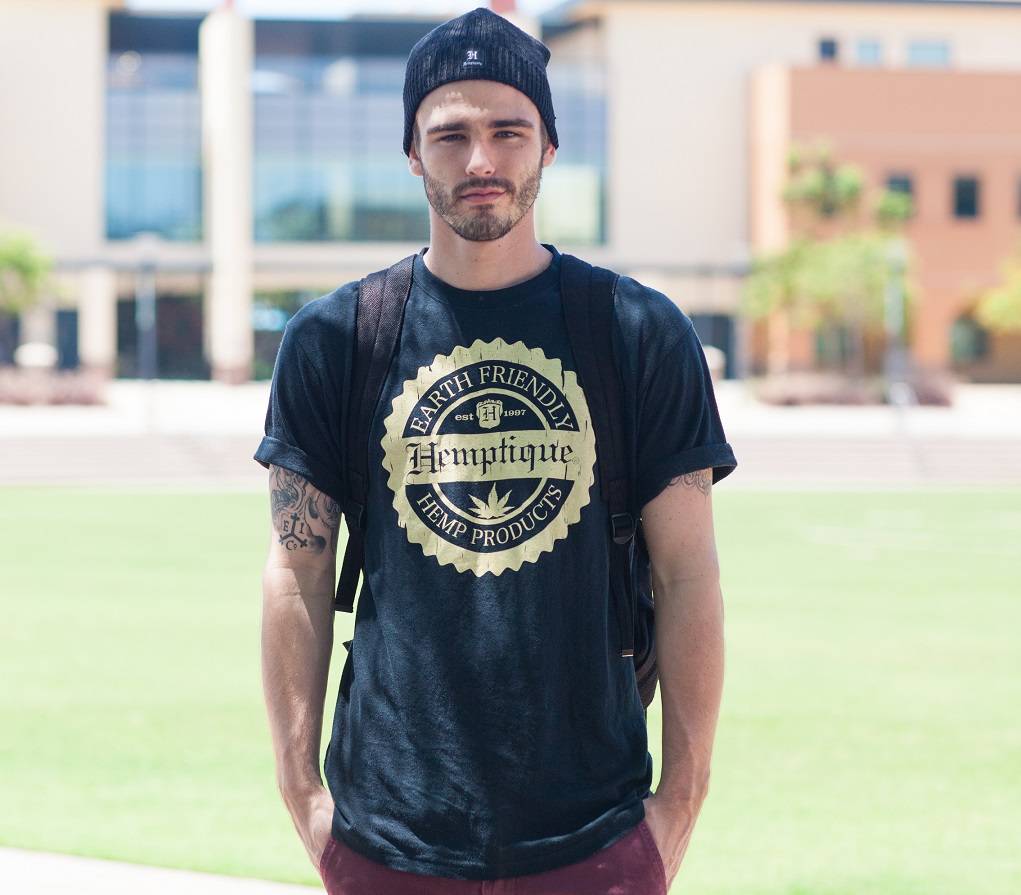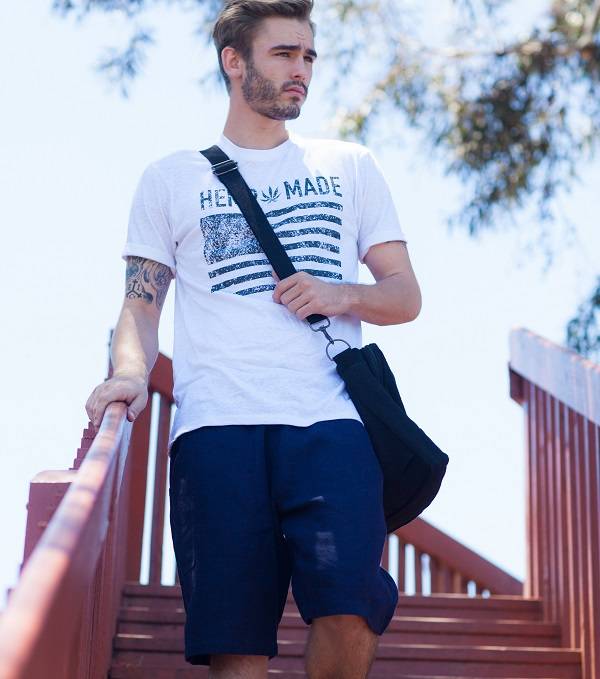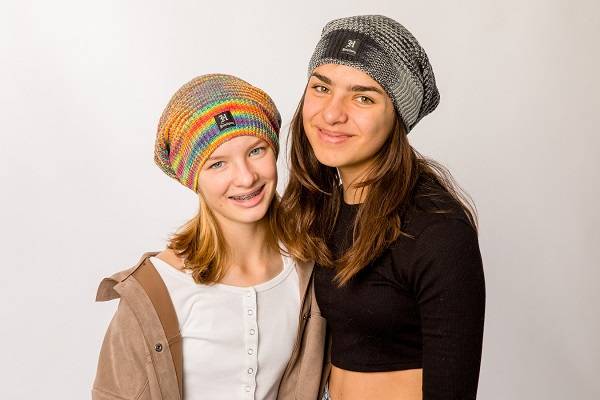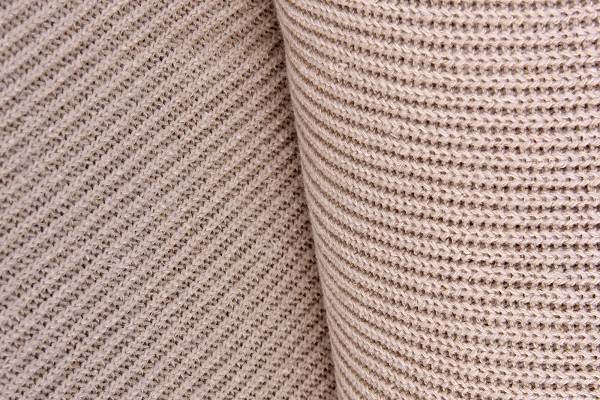Hemp fabric is very soft, but it is also quite durable, as the fibers from this plant are long and tough. While a regular cotton T-shirt lasts 10 years at most, a hemp T-shirt may last double or triple that period.
HEMP CLOTHES 101
15 Benefits of Hemp Clothing
Stay Eco-Friendly With Hemp Textile

Hemp is one of the most diverse natural fibers on the planet, although it is not widely used. While hemp offers numerous health and environmental benefits, certain myths keep people from embracing this wonderful fabric. We want to break down these barriers so that you can reap the full benefits of hemp apparel.
The more we looked into it and experimented with it, the more convinced we became that this plant is the way of the future. Hemp is one of the most environmentally friendly and economically efficient all-natural fibers; it requires less water, grows quicker, cleans the air, and regenerates the soil, bringing life to an under-appreciated planet. Let’s take a look at the benefits of clothing made of hemp, the cannabis family’s sober relative.
Table of Contents:
What is Hemp Fabric?
How Is It Made?
Benefits of Hemp Clothing
Where to Buy 100% Hemp Clothing?
Hemp vs Cotton
FAQs
In addition, we will also introduce you to the most reputable hemp products supplier in the United States, where both retailers and wholesalers may get the best hemp cordage and hemp fiber clothing – Hemptique.
Wholesale Hemp Clothing: Meet Hemptique
Hemptique's main goal is to provide consumers with high-quality, bright, and helpful hemp goods. Creative designs that are environmentally conscious, as well as unique materials, styles, and colors, the use of fiber-reactive Azo-free dyes (which are the most environmentally benign man-made dyes) is one of the most essential elements of Hemptique hemp-based clothing, in addition to labeling and appealing packaging options.
Our hemp products are all-natural, oil-free, biodegradable, farmed sustainably, and consumer-friendly. Our major objective is to provide high-quality, in-demand natural items at a reasonable price.
What is Hemp Fabric?
Hemp fabric is a form of textile manufactured from fibers extracted from the Cannabis sativa plant's stalks. For millennia, this plant has been known as a source of extremely tensile and durable textile fibers, but the psychoactive properties of Cannabis sativa have recently made it more difficult for farmers to grow this extremely valuable crop.
How Is It Made?
The hemp plant’s stalks are made up of two layers: the outer layer is made up of rope-like bast fibers, while the inner layer is made up of woody pith. The outer layer of the Cannabis sativa stalk is used for textiles; the inner, woody layer is typically utilized for fuel, construction materials, and animal bedding.
Hemp fabric is made from the long strands that make up the stem of the plant. Retting removes the fibers from the bark, which are then spun together to make a continuous thread that may be woven into a textile. The plants are left to ret in the field for 4-6 weeks, allowing the pectin to be naturally removed.
The fibrous outer section of the hemp stalks is separated from the woody core and baled like hay. Following that, the bast fibers are cleaned and carded into strands. The raw hemp can subsequently be turned into a weaved thread using steam explosion. After the steam explosion, hemp is ready to be spun into yarn and woven into textiles.
Hemp fabric is made from the long strands that make up the stem of the plant. Retting removes the fibers from the bark, which are then spun together to make a continuous thread that may be woven into a textile. The plants are left to ret in the field for 4-6 weeks, allowing the pectin to be naturally removed.
The fibrous outer section of the hemp stalks is separated from the woody core and baled like hay. Following that, the bast fibers are cleaned and carded into strands. The raw hemp can subsequently be turned into a weaved thread using steam explosion. After the steam explosion, hemp is ready to be spun into yarn and woven into textiles.
Benefits of Hemp Clothing
Pure hemp fiber has a texture similar to that of linen. It can also be used with other natural fibers to create clothing with the strength of hemp but the softness of cotton or bamboo. Hemp fabric is resilient, pleasant, and environmentally friendly because it is made completely of natural fibers. The fabric is also antimicrobial, hypoallergenic, and anti-static. So, let's plunge into the full list of hemp clothes benefits.
1. Strong & Durable
The clothing’s actual worth is determined by its durability and strength. Hemp clothing offers three to four times the strength of cotton clothes. It is one of hemp fabrics’ distinguishing features, and it sets it apart from conventional garments.
2. It Wears In
Did you know that some textiles become softer with time? Clothes made from hemp certainly fall within that category! The truth is that when you wash and use your hemp clothing, the fabric actually softens and becomes more comfortable. This is by far one of the most distinguishing characteristics of hemp clothing, and it differs from bamboo or cotton clothing. This, together with hemp clothing resilience and longevity, led us to believe in the genuine value of hemp clothing.
3. Breathable & Insulating
Some materials are designed to keep you warm in the winter and cool in the summer, but only a few are capable of doing both. Hemp clothing, like bamboo, performs the same effect. The cellulose strands in hemp clothes have a unique structure that allows them to breathe. Hemp clothing can preserve your true body temperature, which is a significant advantage. This applies to hemp bed sheets, blankets, and pillows, as well as hemp clothes. Hemp and bamboo bed sheets are far superior to cotton ones.

4. Antimicrobial
We have all experienced that weird odor that comes from garments that have not been washed in a while or have sat in the washer for too long. This is not the case with hemp clothing because of its natural antibacterial characteristics. This super-plant has a lot of superpowers! Because hemp clothing is naturally antibacterial, it can keep its scent for longer while also resisting mold and mildew. When opposed to conventional textiles like cotton, this preserves your hemp clothing, as well as the surrounding clothes, from becoming smelly and staying fresh for a long time.
5. Biodegradable
There are instances when our garments become permanently damaged or simply wear out beyond repair. Unfortunately, this means you will not be able to give it to a family member, friend, or charity. Hemp clothing is 100% organically biodegradable, so it is not the end of the world if you throw it away. Obviously, no one likes to throw their clothes away, but it does happen, even to the best of clothes. It is preferable to have clothes that are naturally biodegradable. Clothes that are not naturally biodegradable may spend a long period in a landfill.
6. Highly Renewable
Hemp is a renewable resource that grows quickly. Hemp can be harvested up to three times each year and matures in as little as 120 days. In comparison to cotton, hemp may produce 200-250%more fiber on the same amount of land. What is more, hemp will thrive on the ground that is not suitable for other plants. This also implies that hemp does not have to use up valuable farmland for food, which is always a challenge.
Cotton, forests, and other natural resources that we use for clothing and other commodities grow at a slower rate than hemp. Not only is this beneficial to productivity, but it is also necessary for environmental health to quickly regenerate land and soil after each harvest. Because hemp helps to repair soil, it can be used to grow plants that require healthier soil and a longer time to thrive.
Cotton, forests, and other natural resources that we use for clothing and other commodities grow at a slower rate than hemp. Not only is this beneficial to productivity, but it is also necessary for environmental health to quickly regenerate land and soil after each harvest. Because hemp helps to repair soil, it can be used to grow plants that require healthier soil and a longer time to thrive.
7. No Pesticides
One of the most destructive aspects of the lifecycle of cotton and other fabric-based plants is the usage of toxic chemical fertilizers, insecticides, and herbicides. Hemp clothing, like bamboo, does not require any of these synthetic, hazardous chemical agents, which is great for the environment. In the clothing industry, the usage of toxic chemicals is too widespread, therefore any step away from this tendency is a positive one. The biggest problem is that these toxins end up remaining in our land and streams, polluting our ecosystem severely. This harms all citizens of the earth, including our animal companions, and should be minimized to the greatest extent possible.
8. UV Resistant
The discovery that garments can have UPF (ultraviolet protection factor) characteristics startled us. And hemp is included! We are not sure why the concept of utilizing clothing or fabric to defend against the sun startled us. It clearly is not so new concept, because people used hemp fabric for a long period before the invention of sunscreen. Hemp is naturally UV-protective, making it an excellent choice for UPF fabric. It is 99.9% effective in protecting the skin from both UVA and UVB rays, according to tests. While it is never recommended completely avoid sunscreen, we do believe that some sun exposure is beneficial to our health. Rather than slathering oneself with chemicals, wear hemp clothing and go outside freely.
9. Versatile
Hemp fabric may be used for nearly everything, from underwear to drapes to laptop bags to furniture, and its qualities make it an excellent mixing fabric. As a result, hemp may be used with practically any other fabric to produce a wide range of garments. Hemp fibers can be woven alone or in combination with other materials to create everything from canvas to gauze. The incredible strength of hemp fibers is preserved in these hemp-hybrid textiles, which are softer and prettier. Hemp silk is the most luxurious of them all.

10. Odor-resistant
Hemp clothing, unlike cotton, does not retain body odor due to its natural moisture-wicking properties. Hemp clothing is an excellent choice if you want to smell good all day. Hemp cloth is resistant to mildew and mold because of its antibacterial characteristics, and it absorbs moisture. Many people wonder if hemp garments maintain the plant’s odor. They do not.
11. Water-Absorbent
Staying dry in some weather can be difficult, and it is even more difficult when you are wearing the incorrect textiles. Hemp is able to take in up to 25% of its own weight and at the same time feel dry to the touch. What is more, perspiration is absorbed and released very fast when hemp fabric contacts our skin. This is very important for dryness and freshness, and consequently, less moisture is kept for a comfortable feeling on our skin.
12. Environmentally Friendly
The hemp plant does not take up a lot of space to grow and has a high land efficiency—it takes half the land area to produce the same amount of hemp compared to cotton.
Hemp is extremely gentle on the earth, returning 60% of the minerals it consumes as it grows (if dried in the field). Hemp has been farmed on the same soil for 20 years without soil depletion as a result of this. Cotton, on the other hand, must be replaced with a different plant every few years or the soil will lack the necessary nutrients. Hemp also has phytoremediation characteristics, which means it may remove pollutants from soil and groundwater in a simple way. Heavy metals, radioactive materials, pesticides, herbicides, explosives, and fuels are all known to be removed by hemp.
Hemp absorbs more CO2 than trees during its life cycle, absorbing 3-6 tons per acre versus 1-3 tons per acre for trees. It simply means that while hemp is growing, it is absorbing all of that CO2 and assisting the environment.
Hemp is extremely gentle on the earth, returning 60% of the minerals it consumes as it grows (if dried in the field). Hemp has been farmed on the same soil for 20 years without soil depletion as a result of this. Cotton, on the other hand, must be replaced with a different plant every few years or the soil will lack the necessary nutrients. Hemp also has phytoremediation characteristics, which means it may remove pollutants from soil and groundwater in a simple way. Heavy metals, radioactive materials, pesticides, herbicides, explosives, and fuels are all known to be removed by hemp.
Hemp absorbs more CO2 than trees during its life cycle, absorbing 3-6 tons per acre versus 1-3 tons per acre for trees. It simply means that while hemp is growing, it is absorbing all of that CO2 and assisting the environment.
13. Soft on Skin
In terms of softness, hemp clothing provides a good level of comfort. It is just one of those fabrics that, regardless of the thread count, look and feel amazing. This is because of the fineness of the hemp fibers. In fact, the same thread count experienced with linen and cotton versus hemp gives a gentler feeling! The higher the hemp content in your cloth, the softer it will feel. Who would not want something like this?
14. Abrasion-resistant
You know how it feels when your jacket gets abrasions from hitting it against a wall, door, or other hard objects by accident. Hemp clothing, fortunately, is significantly less prone to do so due to its strong and lasting characteristics.
Hemp, unlike other fabrics, is less amorphous, which means it holds its shape better. This makes it less prone to changing shape at the molecular level, which means knicks and abrasions are less likely to harm the fiber. That is a very strong cloth we have got there.
Hemp, unlike other fabrics, is less amorphous, which means it holds its shape better. This makes it less prone to changing shape at the molecular level, which means knicks and abrasions are less likely to harm the fiber. That is a very strong cloth we have got there.
15. Hypoallergenic
Some people’s skin is extremely sensitive. Wearing the wrong cloth might cause a lot of itching and redness in various regions of their body. Hemp fabric, fortunately, is hypoallergenic. It does not irritate the skin and can even kill bacteria that come into contact with it. Hemp cloth is extremely sanitary as a result of its antibacterial and antifungal properties.

Hemp vs Cotton
Let’s take a look at how hemp fabric stacks up against cotton on a few key criteria.
- Hemp is a more durable and stronger fabric than cotton. Hemp fabric, like excellent wine, ages gracefully. Hemp fabric lasts longer and is less likely to wear out than cotton. Hemp has three times the tensile and flexible strength of cotton, and it holds its shape and softens with each use and wash.
- Hemp requires much less space than cotton. Hemp productivity levels are far higher, with 2,650 lbs of fiber per acre compared to 1,190 lbs of cotton fiber per acre of land. As you can see, hemp is a fast-growing, well-abundant crop that does not use up all of the available land.
- Hemp enriches the soil, cotton does not. Hemp has a short growing season and a deep root system, allowing for aeration and continuous soil structure improvement. The leaves and hurds can be used as fertilizer by plowing them back into the soil. This aids in the replenishment of soil fertility, which will aid in the growth of the following round of crops. On the contrary, cotton crops use various chemicals, which severely damage the soil as well as the plants’ root system.
- Hemp farming is sustainable, cotton is not. Cotton farming is not as sustainable - it is responsible for over 10% of all agricultural chemicals and 25% of insecticides. These pesticides are among the most dangerous on the market, and they end up in the water. Hemp, on the other hand, is naturally resistant to many diseases, so it does not need any herbicides or pesticides.
- Hemp uses much less water than cotton. Cotton requires 5,280 gallons of water to produce 2.2 lbs of cotton using today’s agricultural farming practices, which is equivalent to a single t-shirt and a pair of jeans. Hemp, on the other hand, uses 80 gallons of water, the majority of which comes from rainfall, to produce 2 lbs of fiber.

Where to Buy 100% Hemp Clothing?
Hemptique offers sustainable crafting and clothing supplies, including 100% hemp woven fabric that is biodegradable, organic, and eco-friendly. It is suitable for home, apparel, and crafting.
FAQ
Is Hemp Clothing Soft?
Does Hemp Shrink?
If you wash hemp clothes in cold water, they will not shrink. Similarly, instead of tumble-drying or line-drying in direct sunlight, air-dry your items to reduce shrinkage. If you must use hot water to remove a stubborn stain, pay special attention to the cycle time.
What Are the Disadvantages of Hemp Fabric?
Hemp materials are prone to wrinkles. Hemp has low flexibility, which is a severe disadvantage. As a result, it is frequently mixed with other materials. Hemp is light and durable, but it requires chemical treatments to keep its elasticity. Also, hemp production is a little more expensive than cotton due to its low availability. Industrial hemp farming is still a small business, so fashion products manufactured from hemp materials are harder to find.






